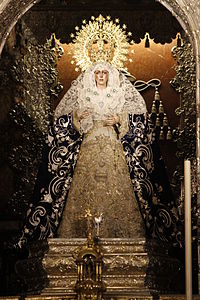Virgin of Hope of Macarena
| Virgin of Hope of Macarena | |
|---|---|
 |
|
| Location | Seville, Spain |
| Date | 18 December |
| Witness | Pedro Roldán, Joselito el Gallo |
| Type | Marian art |
| Holy See approval | 17 February 1963, during the Pontificate of Pope John XXIII |
| Shrine | Basilica of Macarena, Cathedral of Seville |
| Patronage | People of Seville, bullfighters, Gypsies, tailors, embroiderers and liver donors. |
| Attributes | Our Lady of Sorrows holding a handkerchief, rosary and five emerald brooches |
The Virgin of Hope of Macarena (Spanish: Virgen de la Esperanza de Macarena de Sevilla), popularly known as the Virgin of Macarena or simply La Macarena, is a pious 17th century Roman Catholic wooden image of the Blessed Virgin Mary venerated in Seville, Spain. The Marian title falls under a category of Our Lady of Sorrows commemorating the desolate grievance and piety of the Virgin Mary during Holy Week. The image is widely considered as a national treasure by the Spanish people, primarily because of its religious grandeur during Lenten celebrations.
The image is also known for local folklore, most notably its discolored cheek allegedly caused by a wine bottle thrown by a Protestant drunken rebel at her face which pious legends also claim it never been able to remove. Its popularity among the masses is often highlighted in the five Rose-Emerald brooches attached to her dress given by the famed bullfighter José Gómez Ortega, also known as Joselito and El Gallo, and the historical fact that the image has only worn an entire black vestment ensemble on a singular point in Spanish history; during el Gallo's death and funeral.
The feast of the image is celebrated in Spain on 18 December and was granted a canonical coronation on 31 May 1964 by Pope John XXIII via Cardinal José Bueno y Monreal. The Virgin of Macarena is commonly considered the patroness of bullfighters and Spanish Gypsies who hold a sincere devotion to the image. It is currently enshrined in the high altar of the Basilica of Macarena.
The image's genuine authorship is unknown and widely disputed; often by art schools who wish to claim ownership of both its artistic style called Encarnacion. A similar image of the Virgin Mary and crucified Jesus was certainly in existence by 1654 by santero artist Pedro Nieto. Religious images of this type was a result of baroque reforms between 1670 and 1680 by the Confraternity of Macarena.
...
Wikipedia
